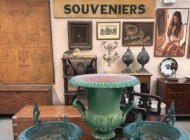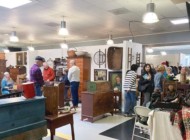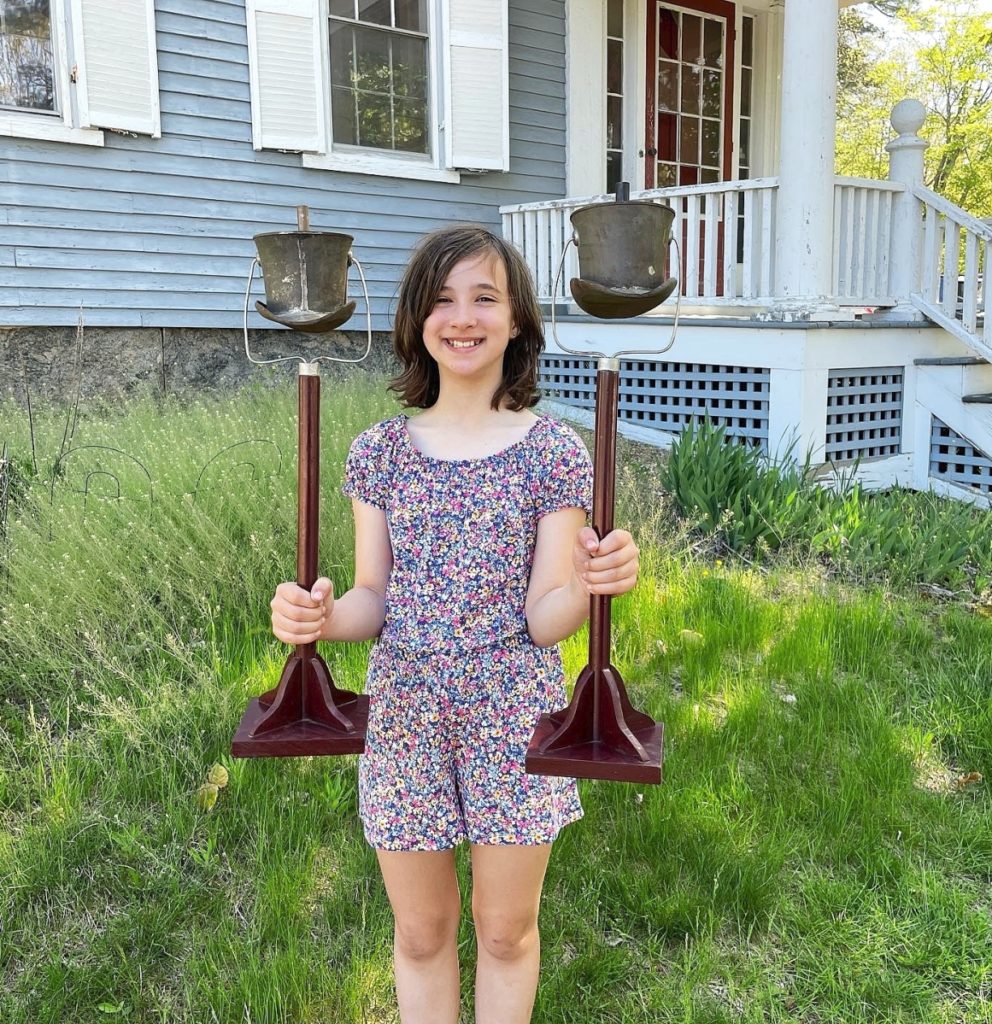
Alexis Thomas, 10, holds the pair of circa 1888 Benjamin Harrison tin top hat parade lanterns that were found in the attic which had descended in the Dow family of Exeter, N.H. The lanterns are complete, although folk art bases were added by the Dow family so the lanterns could be displayed in their home, presumably around Harrison’s presidential campaign or after he was elected President and visited Exeter in the summer of 1889.
Submitted By Justin W. Thomas
EXETER, N.H. – Auctioneer Stephen P. Cyr recently conducted a multigeneration estate sale at 50 Hampton Road (Route 101C) in Exeter. The estate had preserved the Dow family’s occupancy of the farmhouse and attached barn for more than 100 years. The area was also known as “Dow’s Hill,” along the Exeter-Hampton border on Hampton Road; the Dow family is found throughout the area, dating to at least the 1700s. It is rare to find these types of estates still intact in New England today, preserving a family’s history in the area for upwards of 150 or more years.
Among the objects that descended in the family were farm equipment and wagons from the 1800s and early 1900s. Several household objects found throughout the property were also branded or marked “B.W. Dow,” such as a spinning wheel that was possibly made in a Shaker community, two niddy noddies that were also possibly Shaker made, along with various other objects like ladders, some furniture, tools and other possessions. The iron brand used to mark these objects was found in the cellar alongside all sorts of tools.
However, the most historical objects that came from the estate were items related to Benjamin Harrison; two complete intact parade lanterns were found in the attic beside a period framed print of Harrison and a beaver skin top hat retaining its original box. The box reads, “Penn-Craft Hats,” and the label inside the hat indicates it came from John Pyne’s hat store in Harrisburg, Penn.
Born on a farm by the Ohio River in North Bend, Ohio, Benjamin Harrison (1833-1901), a lawyer and Presbyterian church leader in Indianapolis, Ind., was selected by the Republican Party to run for president in 1888 and 1892. Harrison was a proponent of strong protective tariffs, sound money and pensions for Civil War veterans. In fact, he was a veteran himself, having served in the Union Army as a colonel, and later confirmed by the United States Senate as a brevet brigadier general of volunteers in 1865. Not only was he the grandson of William Henry Harrison (1773-1841), the Ninth President of the United States, but he was also the great-grandson of Benjamin Harrison V (1726-1791), a founding father of America who signed the Declaration of Independence in 1776.
In 1888, Benjamin Harrison used the campaign slogan, “Grandfather’s hat fits Ben too.” This was to tie him to his famous grandfather. He distributed buttons with top hats, as well as canes and brooches and other objects, making the top hat a sort of symbol for himself. During his presidency, the top hat would also be used to mock Harrison, where cartoonists would place him under a huge top hat, stating how he did not live up to his grandfather’s standards. Ben Harrison kept the top hat theme and used it again during his 1892 campaign, which he ultimately lost to Grover Cleveland (1837-1908).
Among the stops that Harrison made after he was elected president was Exeter, N.H., in the summer of 1889, while he was on his way to Bar Harbor, Maine. He stopped briefly at the Exeter Train Depot on Lincoln Street, which is a few miles along the main road from the Dow property where Cyr conducted the estate sale.
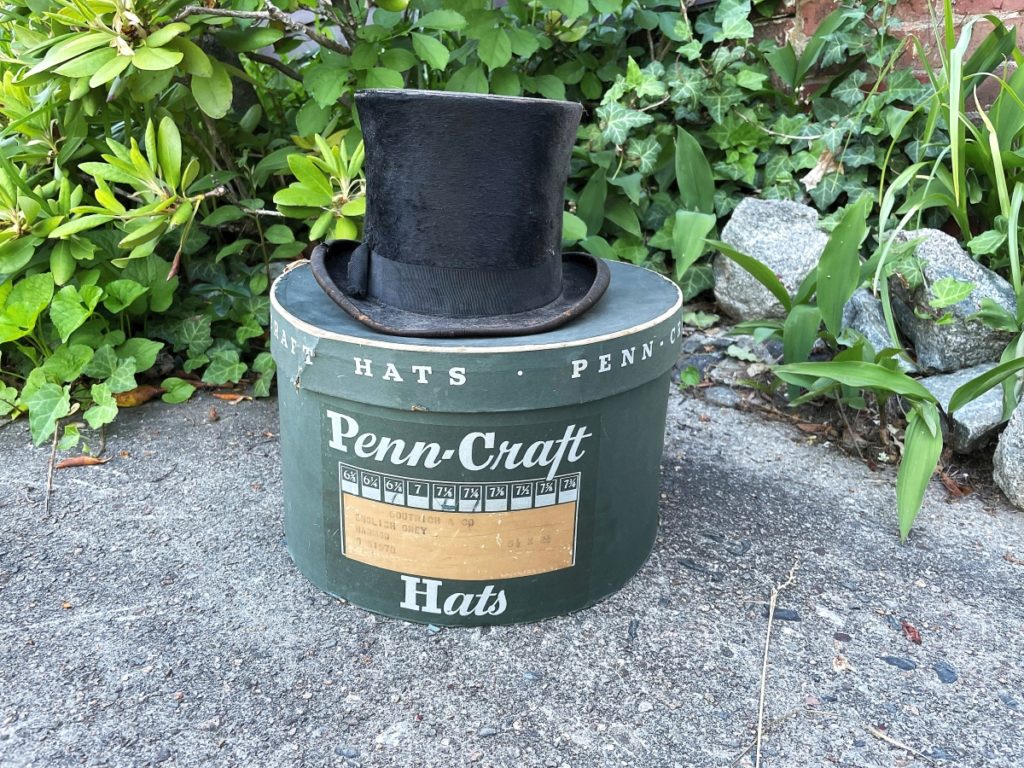
A late 1800s beaver skin top hat with its original box found with the lanterns in the home’s attic. The hat’s label is from John Pyne’s hat shop in Harrisburg, Penn.
The Exeter News-Letter reported that “the presidential train drew into the station at Exeter at fourteen minutes past ten. Citizens of Exeter and neighboring towns, irrespective of party and including many ladies, crowded the platforms. Twelve hundred would be a moderate estimate of their number, and good judges set it at fifteen hundred.”
The Exeter Gazette, however, was less caught up with the specifics. “Shortly after 10 o’clock the special train bearing the President arrived at the Depot where a crowd numbering several hundred was awaiting his arrival. As soon as it came to a standstill a rush was made for the end of the rear car where the President was discovered standing on the platform.”
Both publications then cite the fact that “men swarmed upon the track and crowds surged towards the train until they could grasp the President by hand. Ladies and children crowded upon the car steps for the same purpose. The President stood there shaking hands with the crowd who surged around him in the desire to seize his hand. There were quite a number of ladies among the number who had the pleasure of shaking hands with the Chief Magistrate.”
The lanterns are special, each made from tin in the form of the Harrison top hat, as well as an attached wooden handle that had been carefully modified, but not damaged probably in the late 1800s so they could be displayed in the Dow family home. They are complete and in excellent condition, which is rare today, seeing that other Harrison lanterns are known, but they are often missing their wooden handle or some other part, and their history of ownership in the late 1800s is usually long gone.
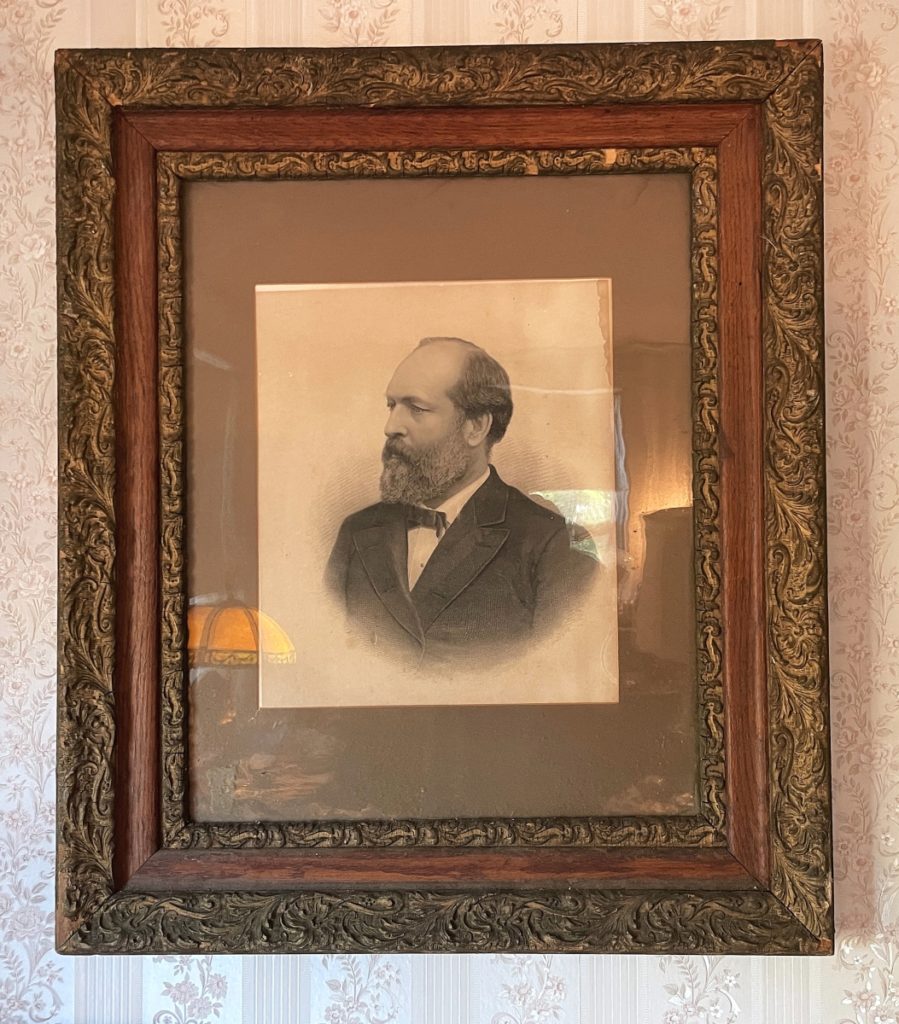
A Nineteenth Century print of Benjamin Harrison in its original frame that was found in the estate.
These lanterns, however, retain a documented history in Exeter. According to a family letter that accompanied them written in 1959 by Doris Dow: “Dear Friends, I am sending the names of the presidents, and date, of the years, they were in office, the first president that I remember was Grover Cleveland, then Benjamin Harrison, and from then until the present date. I feel quite sure those tin hats were used in the parade, when Ben Harrison was elected, as I remember hearing them called “Ben Harrison hats.” I was born in 1882, Ben became president in 1888, I was 7 years old, I watched the parade from the old house, which we now own, and my grandfather, Albert Dow rode horseback in the parade, that was 71 years ago.”
The letter most likely proves the lanterns were originally owned by Albert Dow and perhaps even used in the parade in Exeter in 1888 or when Harrison arrived in 1889.
Additionally, a Nineteenth Century engraving titled “Gettysburg: Repulse of Longstreet’s Assaults” was found in its original oak frame and had also descended in the Dow family. The engraving reveals a detailed view of the battlefield in Gettysburg with Union soldiers in the foreground, July 1-3, 1863. The artwork was created by James Walker (1819-1889), while the engraver was Henry Bryan Hall (1808-1884). It was published by James Drummond Ball in Boston in 1876, who also published some of the most memorable prints of Abraham Lincoln’s assassination. This engraving is owned by the Library of Congress, the Boston Atheneum, among many other museums across the country today.
Other significant objects found in the estate include a Mercedes-Benz from 1972, antique bicycles, a Nineteenth Century horse-drawn wagon, two Nineteenth Century painted sleighs, two ox carts in old paint, a hay wagon and an antique painted wooden sign that read, “Exeter Public Market.” A notable piece of Nineteenth Century folk art was also found in the attic in the form of a painted backgammon gameboard, where the reverse side revealed a checkerboard drawn in pencil, possibly by a child in the late 1800s or early 1900s. The gameboard was made from two early conjoined pine floorboards and probably painted by a member of the Dow family.










